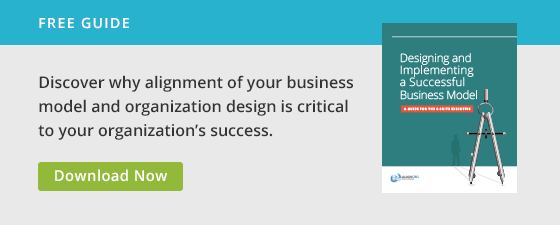Aligning Resources for the Things That Matter in Organizational Design
Optimizing a business model isn’t easy. What’s more, your resources may be limited requiring you to be more thoughtful when aligning your organizational design to your business model. You want to be sure you’re making provisions for the things that really matter.
Without a solid understanding of the parts of the organization that need to fit together, you’ll impede your own efforts and shortchange your customers.
Known Obstacles to Progress
Executives frequently fall prey to common practices, assumptions, or even habits that can encumber alignment. Although these practices may feel normal, natural, and logical, the first step in identifying and aligning your business model and organizational design may be to understand what doesn’t work. Here are a few areas where leaders often get tripped up:
1) Cocktail napkin planning: Who among us hasn’t taken this approach to planning and designing an organization? Hastily sketch out the who, what, when, and how of an organizational design (How you’ll help customers. Who will be the key players, what you’ll do to get there, and when you’ll launch.) If only it was that easy.
It can be a challenge to convince leaders why this approach to planning rarely works. Simply put, with a hasty plan, you won’t maximize your capabilities or people and it may not support your strategic differentiators. In the end, the changes may feel unnatural and may not take root.
2) Modeling your business after another organization: If differentiation is so important, why would you copy your competitor? What’s more, how you fulfill your customer’s wants or needs depends on the culture, talent and resources of your company—not another company. Instead of developing a business model and organizational design based on what they have within, too many business leaders copy a model that doesn’t fit their organization or their strategy.
3) Focusing too much on speed to market: You wouldn’t rush your home’s construction process so why would you do so when implementing a business model or organizational design transformation? Creating one too quickly without thought to how you’ll succeed is like raising all four sides of your house, slapping on a coat of paint, and moving in before you’ve taken the time to install the electricity, plumbing, and insulation. Without making sure all systems are working properly before you move in, you quickly render the house uninhabitable. So develop a business model by taking the time to ensure the organizational design behind it is practical, aligned, and implementable.
4) Taking a simplistic approach to the business model: It is a common refrain, “Things used to be simpler.” Wax nostalgic all you like, but you still have to account for the realities of today. As the saying goes, “What you resist persists.” Resist change within your organization all you want. It isn’t going away. If organizations want to keep up, they must adapt. Fight it and you’ll soon be obsolete. Chief alignment officers help the organization embrace the need for making needed changes.
These bad habits can be the undoing of your organization. Now that you know where you can trip up your business model, let’s turn our attention to how to avoid falling back into bad habits.
Break the Bad Habit Cycle
It’s difficult to break the established patterns, particularly if you don’t know where and how to start. We’ve developed tools that can help you break the cycle. If employed in the correct order, they can ensure a successful business model and eventual alignment.
Step One: ANCHORs Away
The ANCHOR tool will help you answer critical questions that will affect the shape and scope of your business model and organizational design:
- Where can you reduce costs?
- Which areas of the organization require more capital?
- Will you need to expand your staff in the near future?
- Does each employee’s role make the most of their capabilities?
So know your Audience, their Needs, and the CHannels they use to fulfill those needs. But don’t forget to Omit what won’t work, and always keep an eye that you are driving profitable Revenue for your organization.
Step Two: Dare to be Different
It’s more challenging than ever to be heard above the marketplace din. It can be difficult to distinguish your organization from your competitors and reduce imitations. Differentiators give you an edge. They help you stand out.
Take, as an example, the grocery store Wegmans. The chain provides philanthropic support to communities surrounding their stores. That is one of their differentiators. The upshot is more locals shop at Wegmans because they feel the store cares about their community.
No organization can be all things to all people. So select your strongest differentiators to compete effectively. Differentiation will also help as you implement your business model, ensuring you optimize resources for what really matters.
Step Three: Map the Matrix of Choices
A functional alignment matrix will help you organize and visualize all aspects of your business model. Essentially, it allows you to plan for complete change by ensuring alignment between all the parts of your organization, such as the work, structure, culture, people, and metrics.
Is the balance right? Are there gaps in certain functions? Do all elements of your organization interact seamlessly? Do they support your employees, customers, differentiators, etc.?
Alignment can’t occur if one or more of these choice areas is missing, taking over, falling short, or misaligned with the others.
Step Four: Partner for Lasting Change
Your HR manager or another change partner can be your greatest asset in the process of building and aligning your business model and organizational design. Listen to their perspective. Consider their suggestions. Collaboration will ensure a viable business model and an aligned organization.
Of course, you’ll be tempted to go from 0 to 60, but the process really shouldn’t be rushed. This is where your change partner can prove particularly useful. S/He will temper that urge to rush, make recommendations about the right pace, consider the best way to engage others, and communicate changes to staff.
Furthermore, a good change partner can help plan out a future reorganization—conferring on doable timetables, assembling the right team to develop and implement it, executing several of the tasks, pinpointing capabilities strengths and weaknesses in employees, and engendering support for the plan.




